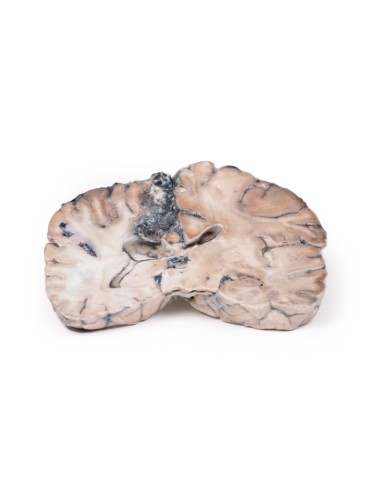Cerebral Arterio-Venous Malformation - Erler Zimmer 3D anatomy Series MP2010
erler zimmerMade in ultra-high resolution 3D printing in full color.
Cerebral Arterio-Venous Malformation - Erler Zimmer 3D anatomy Series MP2010
This dissection model highlighting a Cerebral Arterio-Venous Malformation is part of the exclusive Monash 3D anatomy series, a comprehensive series of human dissections reproduced with ultra-high resolution color 3D printing.
Clinical History.
This patient died at the age of 58 from postoperative complications following transurethral resection of the prostate. At ages 28 and 35, he had suffered two episodes of transient neurological deficit. However, at age 50, he developed permanent hemiparesis of the left leg mainly affecting the ankle.
Pathology
The specimen is a coronal slice of the brain passing through the parietal lobes. The cortex and white matter on the medial aspect of the right cerebral hemisphere have been replaced by a mass of abnormal tissue with a maximum diameter of 4 cm. This lesion extends from the superior surface to the roof of the lateral ventricle. Closer inspection reveals the tissue to be a network of tortuous vascular channels and intermediate tissue.
Histological examination of this arteriovenous malformation showed glial tissue surrounding the dilated vessels. All the vessels had typical endothelial lining, some showed thick muscular walls and others thin walls, thus identifying as arteries and veins, respectively.
Further information
The most frequently observed problems related to cerebral arteriovenous malformations (AVMs) are headaches, seizures, cranial nerve deficits and back pain, and nausea may follow the appearance of clotted blood leaking into the cerebrospinal fluid in the spine. Some patients with AVMs have no symptoms at all. Depending on the location of AVMs, there may also be progressive weakness and numbness and vision changes, as well as excruciating and debilitating pain. In severe cases, the vessels may rupture and cause intracranial hemorrhage. In patients with AVM hemorrhage, symptoms caused by bleeding include loss of consciousness, sudden and severe headache, nausea, vomiting, incontinence, and blurred vision, among others. Local damage at the bleeding site is also possible and can cause seizures, unilateral weakness (hemiparesis, as in this patient), a loss of tactile sensation on one side of the body, and deficits in language processing (aphasia). Ruptured AVMs are responsible for significant mortality and morbidity.
What advantages does the Monash University anatomical dissection collection offer over plastic models or plastinated human specimens?
- Each body replica has been carefully created from selected patient X-ray data or human cadaver specimens selected by a highly trained team of anatomists at the Monash University Center for Human Anatomy Education to illustrate a range of clinically important areas of anatomy with a quality and fidelity that cannot be achieved with conventional anatomical models-this is real anatomy, not stylized anatomy.
- Each body replica has been rigorously checked by a team of highly trained anatomists at the Center for Human Anatomy Education, Monash University, to ensure the anatomical accuracy of the final product.
- The body replicas are not real human tissue and therefore not subject to any barriers of transportation, import, or use in educational facilities that do not hold an anatomy license. The Monash 3D Anatomy dissection series avoids these and other ethical issues that are raised when dealing with plastinated human remains.








